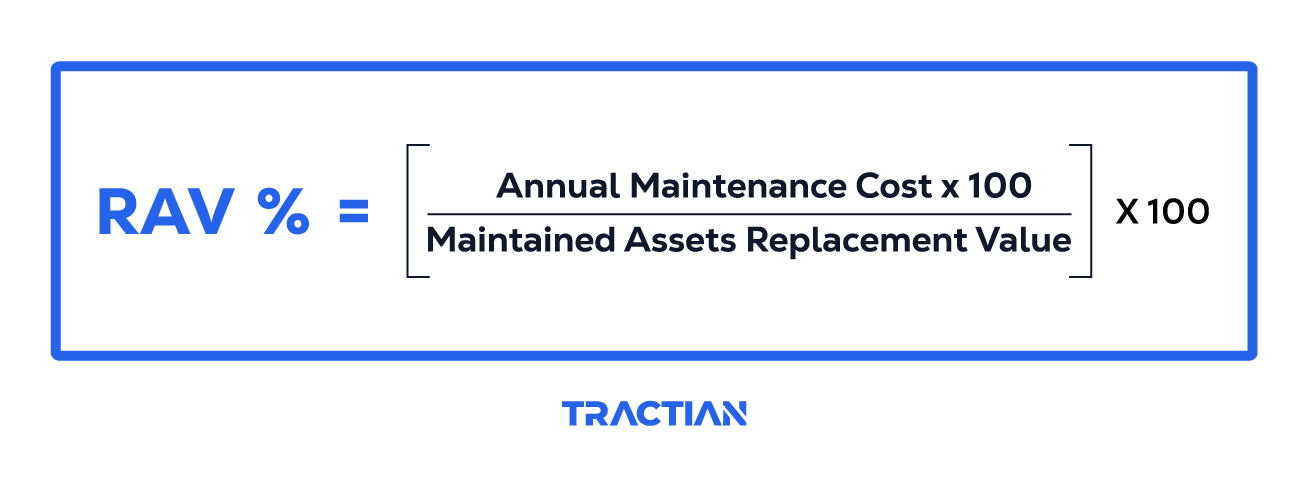Replacement Asset Value (RAV) is the current cost of replacing an asset with another of equal or higher value. It is a useful metric for determining how to manage assets when the need arises to decide between repair or replacement. In broad terms, it encompasses all costs involved throughout the life cycle of an asset, a set of assets, or a factory.
In this article, we will delve into the RAV indicator and its importance in maintaining industrial assets.
ROI and Payback: How to Calculate these Maintenance KPIs
Variables to Consider When Calculating RAV
Replacement Asset Value is the source for calculating several other metrics, guiding decision-making in maintenance and manufacturing operations. Here are some necessary variables and terms to understand when it comes to calculating RAV:
- Technology and complexity of the asset
More complex or technologically advanced assets may require more resources for installation, commissioning, and operation, which could potentially increase the RAV.
- Stage of the asset’s life cycle
Asset age and condition can influence its replacement cost.
- External factors
Market prices, inflation rates, and resource availability can also impact the RAV.
- Depreciation
One essential way to measure the costs of an industrial plant and its assets is to understand the costs associated with depreciation.
Mechanical Failures: Best Practices for Prevention
Depreciation represents the loss of value of tangible assets. Assets are subject to wear over time due to natural processes, or become obsolete – both fall under this category.
It is crucial to emphasize that there are three methods to assess depreciation:
- Linear Method
Uniform, meaning an equal amount of the asset’s value is depreciated each year during its life cycle. This is the most common approach companies use in calculating expenses and loss of value for their assets.
- Percentage Reduction Method
A constant percentage of the asset’s cost is deducted each year. In other words, at the beginning of an asset’s life cycle, the depreciation value is higher than at the end. This is because the reduction in depreciation value occurs progressively as the asset ages.
- Depreciation by Usage
As the name suggests, depreciation is determined by the expected period of use or production of the asset. This method results in the expense used as the depreciation value, the formula for calculation is: Depreciation = original value of the asset x depreciation rate.

Replacement Asset Value (RAV) and Maintenance
The maintenance cost in relation to the RAV is the universal benchmark for the operational performance of an asset. The time it takes for an asset to depreciate can vary, and there are many situations that can contribute to this, including:
- Type and purpose of the asset;
- Time in operation on a day-to-day basis;
- Working conditions;
- Maintenance;
- Conditions of its facilities (if applicable);
- Ways in which it is used.
The way the asset operates and how maintenance is carried out are crucial factors in determining the speed of this depreciation. Understanding the costs involved in maintaining an asset in its basic conditions is essential for evaluating the right time to replace it or not.
Replacement Asset Value Rate (RAV%)
The RAV% is an indicator that will drive an analysis of the maintenance costs for the asset over the course of one year. The variation provides some insights into the health of the asset. For instance, if it’s higher than 3%, it indicates that this asset is spending more than the industry average. If it’s around 2%, it suggests that it belongs to an exclusive group of best maintenance practices.
8 Essential KPIs for Maintenance Management
Operational and maintenance excellence is achieved with a rate of 1%, requiring entirely new mindsets and paradigms throughout the business on how to design, operate, and manage operations.
The calculation of RAV% measures two components of the maintenance process:
Effectiveness: Maintenance can be very effective, with high asset reliability, healthy asset life cycles, and minimal overtime. However, if your maintenance costs are higher than industry benchmarks, you may be performing excessive maintenance on your equipment and/or have an efficiency problem.
Efficiency: If you struggle with low reliability, high reactive maintenance costs, lots of run-to-failure maintenance, and high inventory costs, your team may still be highly efficient, but the effectiveness of your maintenance program is definitely low, and asset performance is likely subpar.

How to Calculate RAV Based on Maintenance Cost?
The maintenance cost as a percentage of RAV can be calculated using the following equation.

Application example: Let’s illustrate based on an asset with a total annual maintenance cost of $100,000.00. This same new asset costs $2,500,000.00 to acquire. Applying the formula, we will have:

It’s a rather simple calculation, but it can be influenced by non-real cost data, so it’s important to be mindful. You may hear people suggest that you should direct maintenance expenses to a maximum of 3% of your RAV. While this may be true for some, every industry will be different. Many variables affect what is considered normal, including:
- Company size
- Geographic location
- Product
- Plant complexity
- Purchase price of equipment and its ongoing maintenance costs
For example, if you have stationary assets in a favorable environment, you can expect a lower percentage of RAV compared to a highly regulated and complex industry operating in a corrosive environment.
Whatever your case may be, you should aim to reduce the percentage without compromising the effectiveness and reliability of your maintenance. Aim to stay in single-digit percentages – the lower, the better. You may encounter difficulties in finding reliable industry benchmark data to measure your performance. If so, use the percentage as an internal KPI to support a continuous improvement initiative.
Differentiating Costs for Asset Groups
Another crucial aspect is the need to differentiate maintenance costs based on the type of asset. Wear can vary significantly, with productive machinery and equipment deteriorating more rapidly than stationary assets like tanks or silos. Additionally, they have vastly different maintenance costs. Therefore, the Replacement Asset Value (RAV) cost should be separated for each category, in addition to having a combined RAV for the operation.
Every asset has an expected lifespan, indicated in the project or projected by the manufacturer. If the current age of the asset represents 70% or more of what was projected, it is considered advanced in age.
We should also note that the condition of use is an indicator of how the asset is being degraded. Every asset has a predicted capacity indicated in the project or by the manufacturer. If it is operating above this capacity, it will have higher failure rates, even if it is not considered advanced in age. The same applies if it is operating in a more aggressive environment than originally projected.
Understanding the life cycle of an asset or industrial plant is crucial for maintaining the financial health of an organization. To address these needs, we have many maintenance tools and strategies. That’s why this indicator based on RAV, which in maintenance we call MC/RAV – Maintenance Cost over Replacement Value, is important.
How to Achieve Maximum Industrial Asset Availability
To have precise control over maintenance activities and understand the life cycle of an asset according to its design, the solution begins with management. To achieve this, an EAM (Enterprise Asset Management) system is necessary.
This management system is a solution that optimizes processes in carrying out work activities. Additionally, it supports more accurate management of all processes involving maintenance.
With an adequate management system, we improve the possibilities of reducing unwanted downtime, thus extending asset life cycles. This will undoubtedly be reflected in better RAV rates, in addition to optimizing available resources and improving the overall maintenance workflow.
Data and information are fundamental for decision-making in maintenance management, and suitable software makes all the difference.


